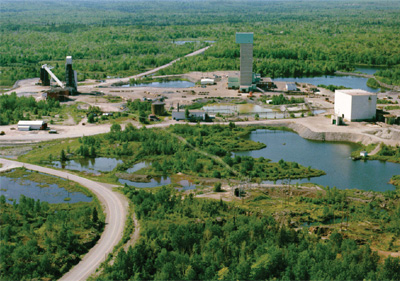 The fourth and smallest mine operator in the Sudbury Basin plans to resume shipping ore by the end of the summer. First Nickel placed its Lockerby Mine on care and maintenance in October 2008 when nickel prices fell below the $5 per pound mark and remained idle through 2009 and 2010.
The fourth and smallest mine operator in the Sudbury Basin plans to resume shipping ore by the end of the summer. First Nickel placed its Lockerby Mine on care and maintenance in October 2008 when nickel prices fell below the $5 per pound mark and remained idle through 2009 and 2010.
The plan now is to extend the ramp another 400 feet to the 6,900-foot level to access a 1.5 million tonne reserve below current mine workings. The company has set a production target of 280,000 tonnes per year “that will take us to at least 2016,” said First Nickel president and CEO William Anderson. “That equates to about 10 million pounds of nickel and six or seven million pounds of copper per year, plus some cobalt.”After laying off most of its workforce in 2008, the company had $8 million in the bank and was spending $400,000 to $500,000 a month keeping the lights on.
Wilderness
“I spent all of 2009 in the wilderness, knocking on any door I could find and, of course, nickel prices kept on going down, so it was pretty grim,” recalled Anderson.
The door knocking eventually paid off. A working capital convertible loan was negotiated with Resource Capital Fund of Denver in the summer of 2009, a $28 million equity financing was concluded in November 2010 and, this spring, Anderson secured a $30 million loan from Société Génerale and Commonwealth Bank of Australia.
The ramp extension and capital expenditures planned for the balance of 2011 would probably have been undertaken in 2009 if not for the global financial collapse.
“In 2008, when metal markets and everything else collapsed, we had finally achieved the resource threshold that would justify the next level of investment, but we couldn’t carry on,” said Anderson.
Anticipating an eventual turnaround, the company spent much of 2009 weighing various options for mining its newly outlined Depth Zone.
Acquired from Falconbridge in June 2005, Lockerby Mine yielded eight million tonnes of ore over a 30-year period beginning in 1974. The mine has two shafts extending to the 4,000-foot level and a winz descending to a depth of 5,300 feet. A ramp extends from that point to the 6,500-foot level.
“The elegant engineering solution would be to extend one of the shafts to the 7,000-foot level, but there aren’t enough reserves and the economics (don’t warrant it),” said Anderson. “We spent a lot of time thinking about how we could change the infrastructure, but at the end of the day, we concluded that what we had was the best we could do unless we found something significantly more in the future, which I wouldn’t rule out.”
First Nickel went into production in 2006 with the idea of mining the remaining known reserve and spending some money to better define the resource at depth.
Orebody
“There were holes down there so there wasn’t any question that the orebody continued,” said Anderson. “It was more a question of how much of a resource was down there and if we could access it and make a profit on it.
“We struggled for a couple years while we were mining because we were drilling at the same time and didn’t have the underground development ahead of us to ramp up our throughput, so we averaged 400 to 500 tonnes per day at best, which is not optimized for that mine by any means.”
A production rate of 800 tonnes per day is anticipated by mid-2012, at which time more drilling will be undertaken at depth.
“There isn’t any doubt that we can add resources and reserves if we go deeper,” said Anderson. “We know the orebody extends to 7,600 or 7,800 feet and it’s still wide open. It’s a question of the breadth. At some point in time, there’ll be a convergence of cost and price and we’ll have to stop, but right now we have a mine plan that takes us to 2016 and, if you’re an optimist, nothing says we couldn’t find something fatter and bigger down there.”
In addition to the extension of the ramp, First Nickel has ordered four new 42-tonne trucks from Atlas Copco and is installing an automated conveyor system on 51 Level to streamline ore handling. It’s also adding cooling units to cope with the higher temperatures at depth.
Capital costs
Capital costs will total $33 to $34 million in the short term and $75 million over the next five years.
The new mine plan also includes a change in stope orientation.
“Rather than our stopes being longitudinal along the axis of the orebody, they will be transverse across the axis,” explained Anderson. “That will give us more work areas.”
Anderson is optimistic about nickel prices.
“There are two camps on nickel. One camp says all of the new mines being built or proposed in the southern hemisphere will come on line, so we’ll stay in balance with the price falling to $8.50 or $9.00.
The other view, which Anderson subscribes to, is more skeptical about big capital projects coming in on time and on budget.
“I don’t have to point fingers at any particular project, but of the hundreds of thousands of tonnes of new nickel scheduled to hit the market in the next few years, I think you can reasonably bet that it won’t all come on time. And with the way capital costs have been increasing on a lot of these projects, even if they do get up and running at full strength, the capital burden on them means they’ll need $10 nickel to cover their costs, so if I’m right, we’ll do very well.”

